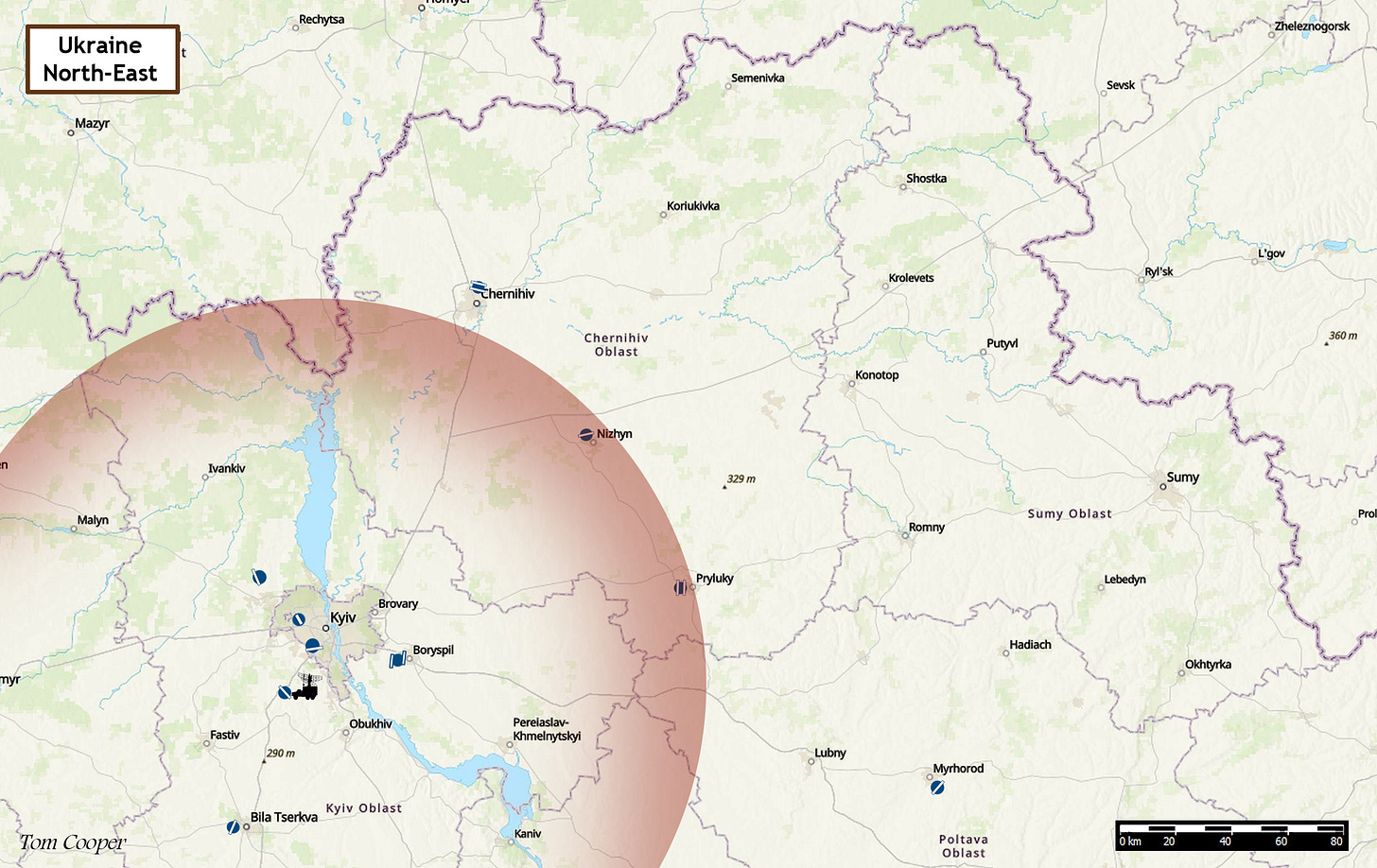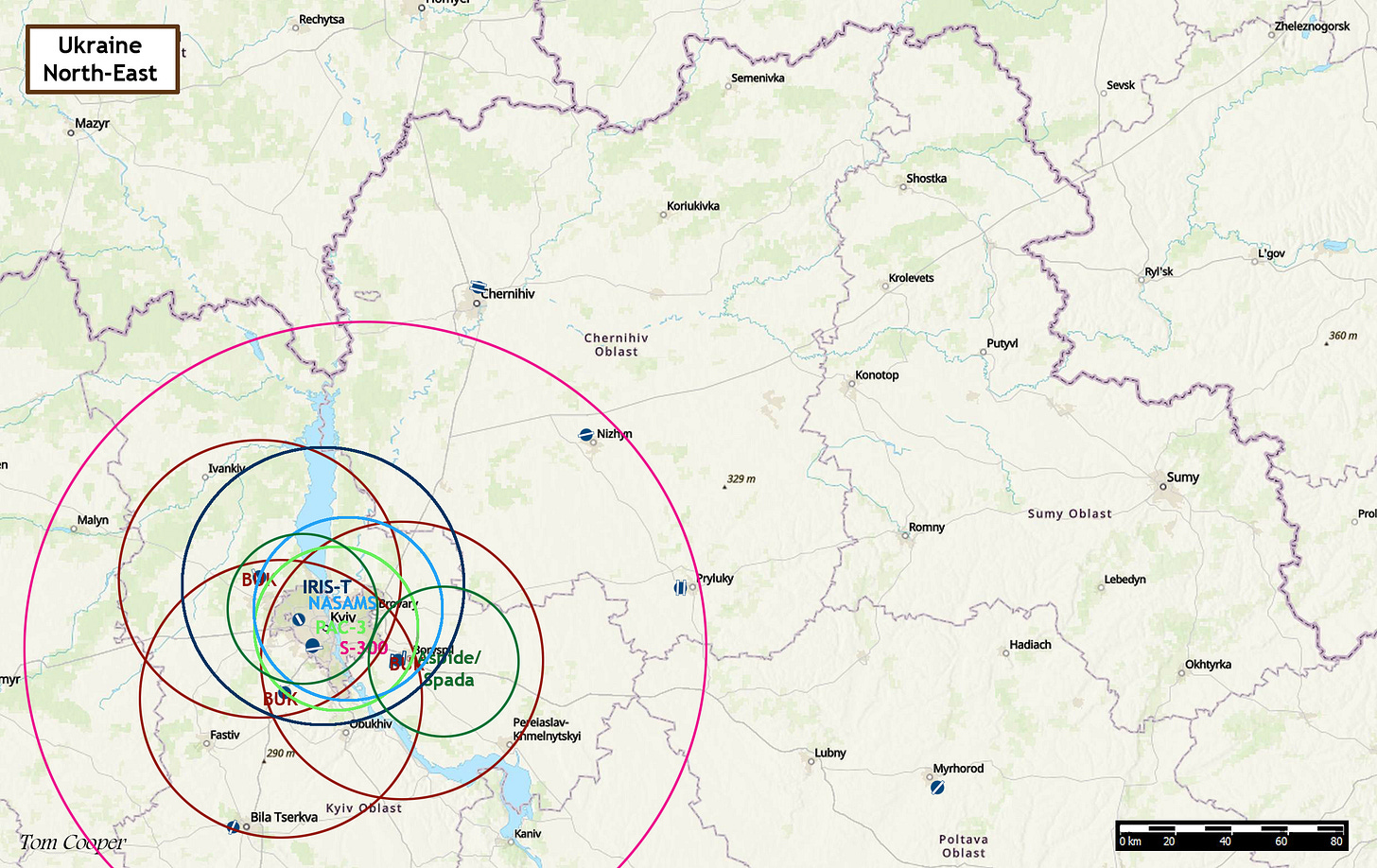Keeping in mind all the ‘details’ I’ve described in the Parts 1, 2, and 3 of this feature, in the Part 4 I would like to offer the first of few examples on how is the air war in Ukraine fought these days.
For the start, I’m going to focus on the situation in the Kyiv area and north-eastern Ukraine.
An important note, up front: none of following maps nor anything of commentary is containing real information. I drew and read everything literally, ‘just for demonstration purposes only’. As examples.
***
Let me guess what I think that ELINT- and SIGINT systems of the Russian GRU could ‘see’ in terms of the activity of the PSU’s ground based air defences, for example, ‘in the Kyiv area, at 05.00hrs of 3 May 2023’.
Not much to see…?
….no SAMs are active….no other radars, but a single P-15…
…and: why P-15…?
Because it’s an old, but reliable radar, with a reasonably good detection range (about 150km). It’s mounted on a truck and thus at least road-mobile: (relatively) easy to re-deploy. Finally, it’s available in numbers left from the times of the Union of Soviet Socialist Republics: if one gets knocked out by Russian anti-radar missiles or other means, there are enough replacements. With other words: in the Year 2023, it is an ideal decoy.
Some 10-15 minutes later, the same ‘picture’ is fed to the ASU battle command system of the OSK South and to the NTUO in Moscow…
Now, put yourself into the boots of the Keystone Cops and the Russian GenStab: from what happened during the last few of their missile strikes on the Kyiv area, they know the PSU is operating ‘lots of SAM-systems there’, and these are shooting down all-, or almost all the missiles fired in this direction. However, all the GRU’s ELINT and SIGINT stations deployed in Belarus and south-western Russia are detecting as of that morning was ‘one old P-15 radar’….?
Moreover, ‘that morning’, this P-15 was ‘on some hill, well to the west of Hostomel’, as shown above. While… hey: yesterday, it was somewhere closer to Kyiv. Say, in the Vasilkyiv area, like here:
….and, day later, it was somewhere else…
What shall the Russians do?
They have (at least) three options:
A) Do nothing, just continue monitoring – by GRU’s ELINT and SIGINT stations, and by such COMINT/SIGINT/ELINT aircraft like Ilyushin Il-20 or Tupolev Tu-214R. Is the easiest solution, costs no additional effort, though results in nothing special in terms of intelligence collected. This is not the way the Russians fight wars, though… (and even less so the way Putin is fighting this war).
B) Send in the GRU Spetsnaz into long-range reconnaissance of the Kyiv area. It’s a big city, there’s lots of place to hide few troops wearing civilian clothes, fluent in Ukrainian, knowing the city, operating with help of a few ‘safe houses’ and discrete contacts to local sympathisers and supporters. Then let them run reconnaissance: ‘by sheer accident’ drive by one, two, three and/or more of Ukrainian SAM-sites somewhere in the Kyiv area; memorise its/their position and equipment, and report the same ‘back to Moscow’. Yes, this sounds cool, but takes time to organise, and results are uncertain. Still, this is one of the ways the Russians do fight wars….but, not the only one.
C) Or, though ideally, the Russians can prompt the PSU’s SAM-sites into action. Force them to activate their radars and thus reveal their reaction time, their positions, and their numbers – and enable the Russians to record all of that with their SIGINT/ELINT-gathering aircraft and ground stations: indeed, to precisely establish their positions, and their strenght.
I guess the Russians went for the Options B and C already late the last year. At least around the time the GRU and FSB began receiving intelligence that a delivery of such Western SAM-systems like IRIS-T, NASAMS, and MIM-104 Patriot was imminent. They began deploying Spetsnaz inside Ukraine. For example: infiltrating them via the less-well-protected sections of the border between Belarus and Ukraine.
Furthermore, knowing that Ukrainians can count on support of Belarusian opposition…indeed,
a) assessing it for certain that the Ukrainian intelligence is maintaining a network of informers in Belarus, and this is providing intelligence on the movement of VKS aircraft based there, and
b) knowing that NATO early warning- and reconnaissance systems are carefully tracking all the movement of Russian aircraft in Belarus (for example: by E-3s on station over Poland, by satellites, by activities of its own intelligence network in the country),
they have decided to start ‘testing’ and ‘sniffing’ the new composition of the Ukrainian IADS.
This is a ‘normal’, indeed ‘routine’ procedure – whether at war or in peace. That’s why, just for example, the US, British, French, Italian, Swedish, and other reconnaissance aircraft are regularly monitoring exercises of the armed forces of the Russian Federation, People’s Republic of China (PRC), Islamic Republic of Iran (IRI)….you name them. The aircraft in question (supported by a host of ground bases) are searching for, detecting, tracking, and recording electronic emissions of enemy radars, communication systems, electronic warfare systems etc., so the intelligence services can develop suitable countermeasures. That’s why some of countries in question (PRC in particular, the IRI too….and, lately, Russia as well), are doing their utmost to hinder such operations, already in peace….for example by flying their Shenyang J-8 interceptors too close, and then colliding with US Navy’s Lockheed EP-3 Aries II reconnaissance aircraft; by shooting down Northrop Grumman RQ-4 Global Hawk BAMS-D UAVs by SAMs; or trying to crash USAF General Atomics MQ-9 Reaper UAVs over the Black Sea, and then colliding with one….all by sheer accident, of course…
But I’m digressing…. Point is: the Russian Federation and Ukraine are in a state of….ahem…’special military operation’; the PSU is on alert and thus it’s not easy to provoke it into action by ‘usual’ means. That’s why beginning (from memory) with March and April this year we’ve ‘seen/heard’ reports in the social media about the release of balloons with radar reflectors over Belarus.
Balloons are cheap, but not entirely dependable tools: can easily get blown off course by unexpected winds at higher altitudes. Thus, I guess that didn’t work that well. This is why VKS began randomly scrambling its MiG-31Ks from air bases in Belarus, in turn prompting Kyiv into sounding air raid alerts whenever one is airborne. However, MiG-31Ks are big aircraft, detectable by NATO’s E-3s even from 300-400km away….and NATO is ‘feeding’ related intel almost straight into the PSU’s integrated air defence system… Thus, that didn’t work really well, either….
One way or the other, and for whatever reason, on 4 May 2023 Putin then ordered a strike by one of his favourite weapons. Indeed, one for whose development he’s left the Keystone Cops invest heavily (so much so, money was re-routed into its research and development, while VSRF’s troops were exercising- and paid less): MiG-31K armed with Kinzhal
….and that, against an unknown target in the Kyiv area. Eventually, the target didn’t matter that much: that was foremost a mission with ‘demonstrative’ character. Free along the motto, ‘see here, our super-turbo Wunderwaffe, which all of NATO knows you can’t shot down, is hitting you… Russia stronk…’
Bam!
That Kinzhal was shot down. Probably in an action in which one of Ukrainian MIM-104Fs (aka PAC-3CRI) was active for mere 60-120 seconds. Barely enough for the Russian means of ELINT and SIGINT to detect its activity, not to talk about properly tracking and establishing its precise location.
‘Impossible!’ - or if, then it ‘must’ve been an accident’. And of course, ‘we’ve got to teach them the lesson….both pesky Ukrainians and those disgusting sons of a gun from ‘Murika: destroy their Patriot!’
Obviously, this is a much more complex issue than ‘just lobbying a single Kinzhal at Kyiv’. Therefore, a new, this time much more powerful strike was ordered, better coordinated than ever before: it was to include ‘cheap/worthless’ Shahed-131/136 loitering precision guided missiles and old Kh-55 cruise missiles – both serving as decoys: means of forcing the PSU’s integrated air defence system to power up not only its early warning radars, but all of its new SAM-sites, too. A total of 6 Kinzhals and at least 3 Iskandar-Ms and S-300s were to be fired around the time Shaheds and cruise missiles were approaching Kyiv; Ukrainian air defences on full alert and thus their radar systems active, enabling triangulation of the MIM-104F’s position: their purpose was to kill that SAM-site, smash it to pieces.
….and of course, the entire action was carefully monitored by the GRU, and every electronic emission carefully recorded. Because, when the PSU’s IADS powered up in reaction to the missile strike on the morning of 16 May, ‘all of a sudden’ the situation was looking something like this:
….while, just few minutes later, after the end of the Russian missile strike, it was back to something like this:
….and every of involved Russians can bet his income of the next 10 years, that all the SAM-sites activated during that attack were in the process of packing and re-deploying to new positions in a matter of 2 minutes after the end of that air strike.
….which is also why Kyiv is so strict and arresting people releasing videos shown activity of the PSU’s SAMs, no matter where in Ukraine. Because every small bit of intel matters, no matter what kind of info it contains, or who has revealed it.
(to be continued….)








Thanks, Tom. This is simply the best thing to do on Sunday morning. Super appreciated.
thank you for the insight of how things work IRL, not in a Hollywood movie. Two slightly related questions:
- is this the same on the frontline from the PSU perspective? After the first few surprise hits with HARM, there are no news about any new successes. Do the Russians work in the same silent mode?
- Probably another few thousand other people has asked you in the past few days about the F-16 delivery decision. I remember well your assessment about why jets shouldn't be on the top of the supply list, but now as they WILL BE there - what can it change? According to the training plan assessment their main role will be air-to-ground missions, not air combat. (no surprise)
Based on what you wrote I assume that beside they can deploy all the western gadgets without tinkering, their presence can be an indirect air defence impact as well. The russians use their S-300 as ballistic missiles regularly - but if there is a new air threat they must revert some of them to their original role. they also can not shoot away a salvo of them being sure that they won't be caught with their pants down. This could - i think - lift some weight off from the Kyiv-like air defenses.